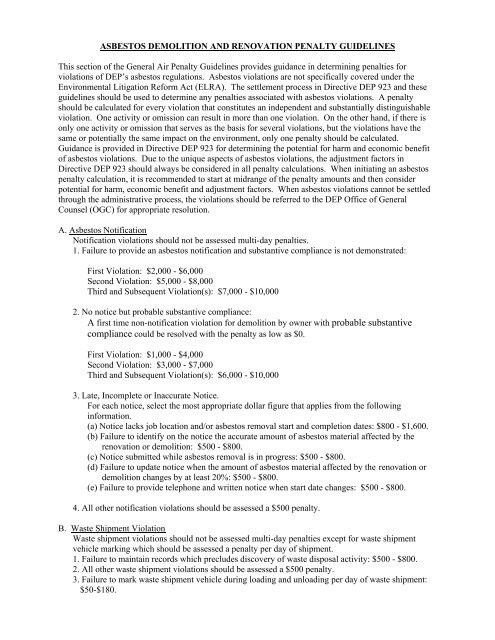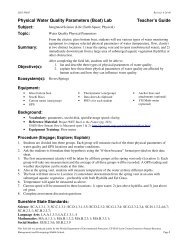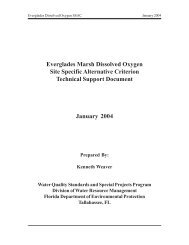ASBESTOS DEMOLITION AND RENOVATION PENALTY ...
ASBESTOS DEMOLITION AND RENOVATION PENALTY ...
ASBESTOS DEMOLITION AND RENOVATION PENALTY ...
You also want an ePaper? Increase the reach of your titles
YUMPU automatically turns print PDFs into web optimized ePapers that Google loves.
<strong>ASBESTOS</strong> <strong>DEMOLITION</strong> <strong>AND</strong> <strong>RENOVATION</strong> <strong>PENALTY</strong> GUIDELINES<br />
This section of the General Air Penalty Guidelines provides guidance in determining penalties for<br />
violations of DEP’s asbestos regulations. Asbestos violations are not specifically covered under the<br />
Environmental Litigation Reform Act (ELRA). The settlement process in Directive DEP 923 and these<br />
guidelines should be used to determine any penalties associated with asbestos violations. A penalty<br />
should be calculated for every violation that constitutes an independent and substantially distinguishable<br />
violation. One activity or omission can result in more than one violation. On the other hand, if there is<br />
only one activity or omission that serves as the basis for several violations, but the violations have the<br />
same or potentially the same impact on the environment, only one penalty should be calculated.<br />
Guidance is provided in Directive DEP 923 for determining the potential for harm and economic benefit<br />
of asbestos violations. Due to the unique aspects of asbestos violations, the adjustment factors in<br />
Directive DEP 923 should always be considered in all penalty calculations. When initiating an asbestos<br />
penalty calculation, it is recommended to start at midrange of the penalty amounts and then consider<br />
potential for harm, economic benefit and adjustment factors. When asbestos violations cannot be settled<br />
through the administrative process, the violations should be referred to the DEP Office of General<br />
Counsel (OGC) for appropriate resolution.<br />
A. Asbestos Notification<br />
Notification violations should not be assessed multi-day penalties.<br />
1. Failure to provide an asbestos notification and substantive compliance is not demonstrated:<br />
First Violation: $2,000 - $6,000<br />
Second Violation: $5,000 - $8,000<br />
Third and Subsequent Violation(s): $7,000 - $10,000<br />
2. No notice but probable substantive compliance:<br />
A first time non-notification violation for demolition by owner with probable substantive<br />
compliance could be resolved with the penalty as low as $0.<br />
First Violation: $1,000 - $4,000<br />
Second Violation: $3,000 - $7,000<br />
Third and Subsequent Violation(s): $6,000 - $10,000<br />
3. Late, Incomplete or Inaccurate Notice.<br />
For each notice, select the most appropriate dollar figure that applies from the following<br />
information.<br />
(a) Notice lacks job location and/or asbestos removal start and completion dates: $800 - $1,600.<br />
(b) Failure to identify on the notice the accurate amount of asbestos material affected by the<br />
renovation or demolition: $500 - $800.<br />
(c) Notice submitted while asbestos removal is in progress: $500 - $800.<br />
(d) Failure to update notice when the amount of asbestos material affected by the renovation or<br />
demolition changes by at least 20%: $500 - $800.<br />
(e) Failure to provide telephone and written notice when start date changes: $500 - $800.<br />
4. All other notification violations should be assessed a $500 penalty.<br />
B. Waste Shipment Violation<br />
Waste shipment violations should not be assessed multi-day penalties except for waste shipment<br />
vehicle marking which should be assessed a penalty per day of shipment.<br />
1. Failure to maintain records which precludes discovery of waste disposal activity: $500 - $800.<br />
2. All other waste shipment violations should be assessed a $500 penalty.<br />
3. Failure to mark waste shipment vehicle during loading and unloading per day of waste shipment:<br />
$50-$180.
C. Work-Practice, Emission or Other Violations<br />
Multi-day penalties are appropriate when daily advantage is being gained by the violator for an<br />
ongoing, egregious violation. Circumstances where multi-day penalties are appropriate include when<br />
the violator knew of the violation after the first day it occurred and either failed to mitigate the<br />
violation or took action that resulted in the violation continuing. An economic benefit being gained<br />
from an ongoing violation is another circumstance that could involve the use of multi-day penalties.<br />
The penalties should be calculated by multiplying the appropriate daily penalty or a part thereof by<br />
the number of days of noncompliance. Adjustment factors, such as good faith/ lack of good faith,<br />
may be used to calculate the daily penalty.<br />
1. Economic Benefit Component<br />
It is DEP's policy to ensure future compliance by eliminating as much of the economic benefit of<br />
violations by adding an economic benefit of non-compliance, where appropriate and practical, to all<br />
civil penalty calculations. Penalties should be calculated in an amount sufficient to ensure future<br />
compliance.<br />
For asbestos on pipes or other facility components: - $20 per linear, square or cubic foot of asbestos<br />
for any substantive violation.<br />
For any significant economic benefits the District staff should request that OGC or a DEP financial<br />
analyst assist in the development of an appropriate economic benefit penalty amount.<br />
2. Environmental Harm Component<br />
Total<br />
amount of<br />
asbestos<br />
involved<br />
1 st Violation<br />
Each<br />
add. day<br />
2 nd Violation<br />
Each<br />
add. day<br />
3 rd and<br />
Subsequent<br />
Violations<br />
Each<br />
add. day<br />
< 10 units<br />
$500 -<br />
$2,500<br />
$200<br />
$2,500 -<br />
$6,000<br />
$600<br />
$6,000 -<br />
$10,000<br />
$1,000<br />
>10 units<br />
< 50 units<br />
$1,000 -<br />
$4,500<br />
$400<br />
$4,000 -<br />
$7,500<br />
$800<br />
$7,000 -<br />
$10,000<br />
$1,000<br />
> 50 units<br />
$2,500 -<br />
$6,000<br />
$600<br />
$5,000 -<br />
$8,500<br />
$1,000<br />
$7,000 -<br />
$10,000<br />
$1,000<br />
Unit = 260 linear feet, 160 square feet or 35 cubic feet - if more than one unit type is involved,<br />
convert each amount to units and add together.






